Exploring the Impact of Project Based Learning in High School Settings
VerifiedAdded on 2023/06/03
|19
|4450
|395
Report
AI Summary
This report provides a comprehensive overview of Project Based Learning (PBL) as an effective instructional approach in high schools. It explores how PBL enhances student engagement, promotes self-directed learning, and prepares students for real-world challenges. The report draws from existing literature, research, and practical examples to illustrate the potential of PBL in fostering deeper understanding and critical thinking skills. It discusses the core elements of PBL, its integration with educational technology, and the development of essential skills such as communication, critical thinking, and problem-solving. The report also examines the evolution of learning methodologies, contrasting traditional passive learning with the dynamic, student-centered approach of PBL. Furthermore, it highlights the importance of authentic assessment strategies and the role of teachers as facilitators in creating engaging and effective learning environments. The report concludes by emphasizing the importance of PBL in developing lifelong learners and equipping students with the skills necessary for success in an evolving world.
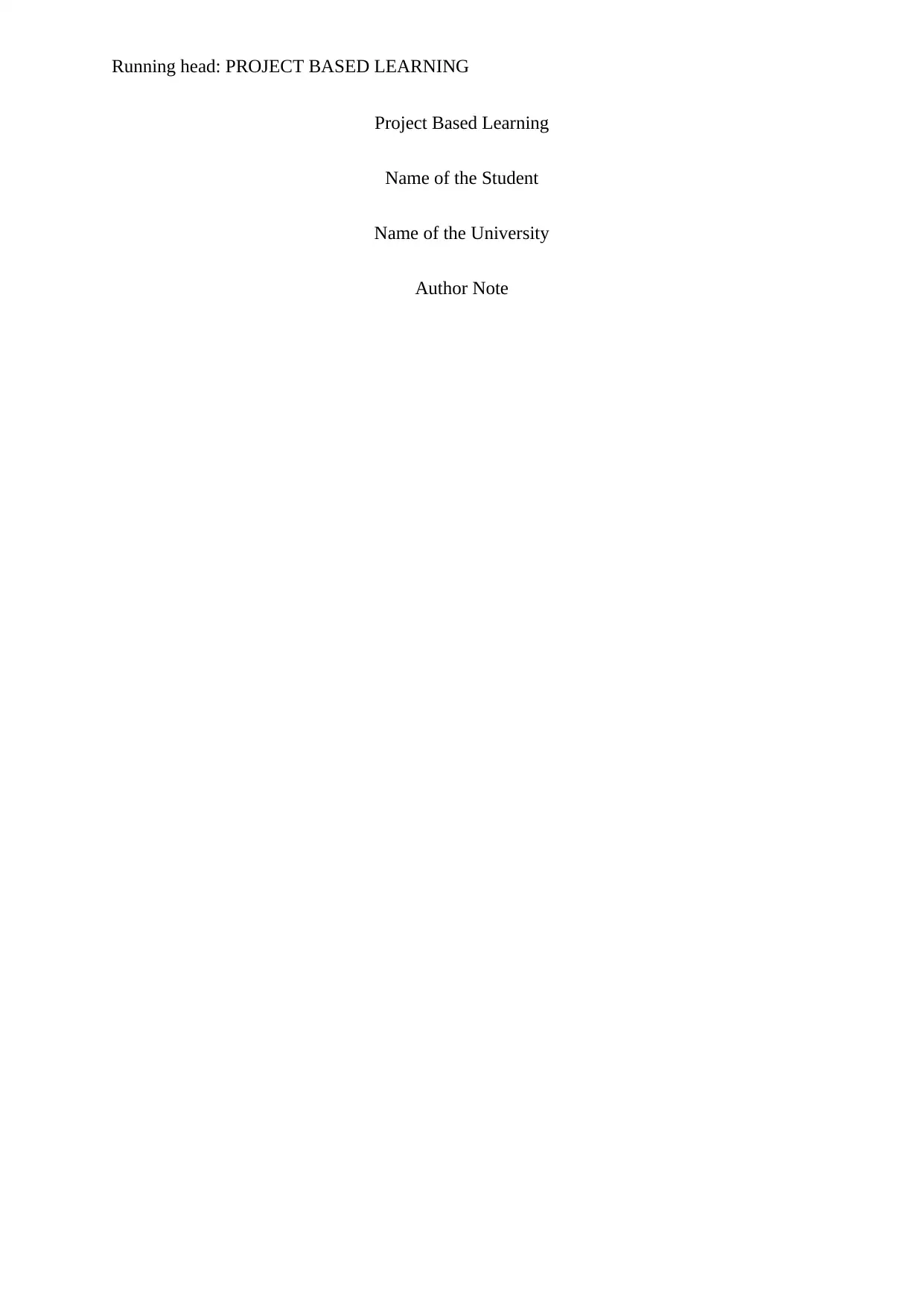
Running head: PROJECT BASED LEARNING
Project Based Learning
Name of the Student
Name of the University
Author Note
Project Based Learning
Name of the Student
Name of the University
Author Note
Paraphrase This Document
Need a fresh take? Get an instant paraphrase of this document with our AI Paraphraser
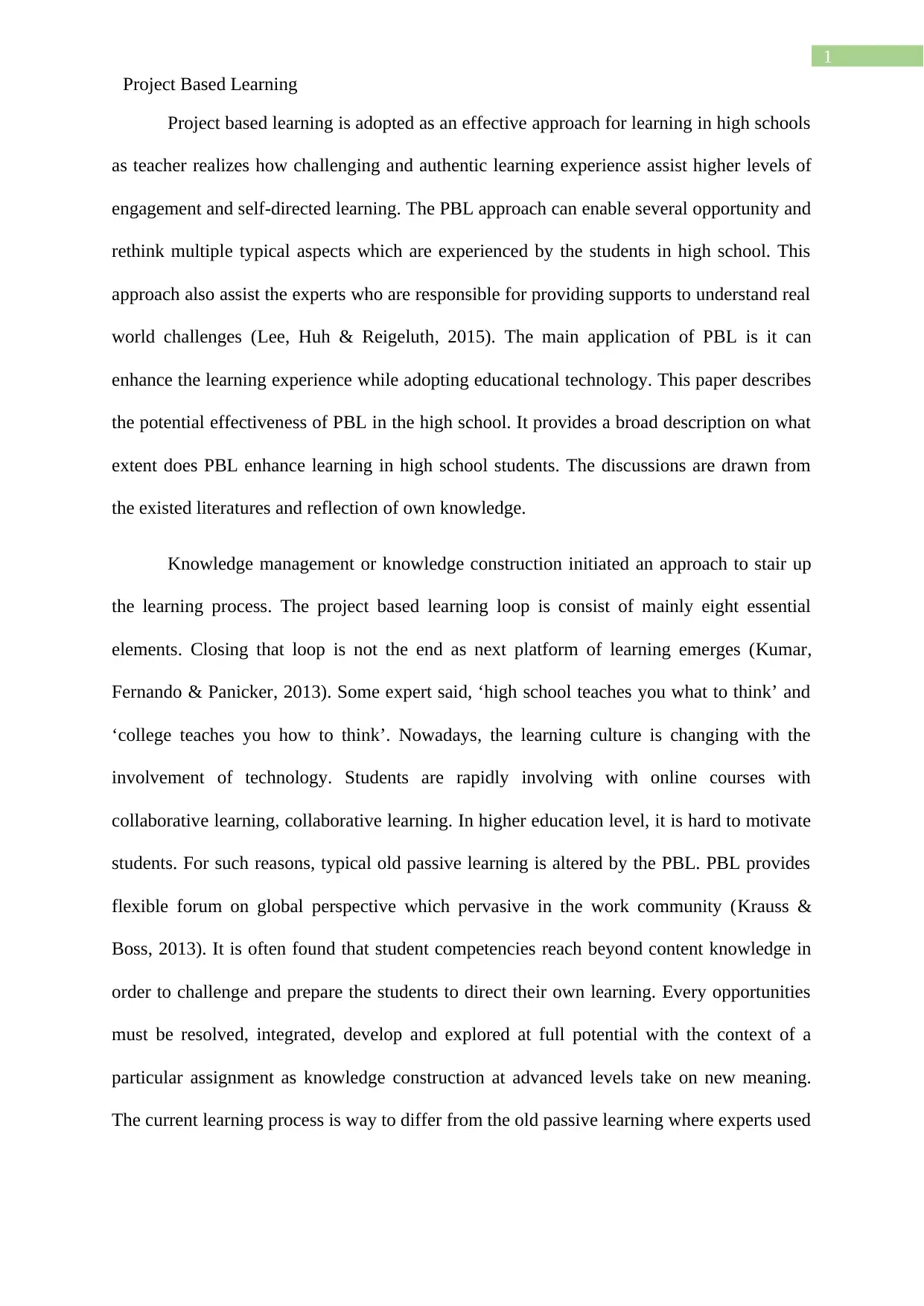
1
Project Based Learning
Project based learning is adopted as an effective approach for learning in high schools
as teacher realizes how challenging and authentic learning experience assist higher levels of
engagement and self-directed learning. The PBL approach can enable several opportunity and
rethink multiple typical aspects which are experienced by the students in high school. This
approach also assist the experts who are responsible for providing supports to understand real
world challenges (Lee, Huh & Reigeluth, 2015). The main application of PBL is it can
enhance the learning experience while adopting educational technology. This paper describes
the potential effectiveness of PBL in the high school. It provides a broad description on what
extent does PBL enhance learning in high school students. The discussions are drawn from
the existed literatures and reflection of own knowledge.
Knowledge management or knowledge construction initiated an approach to stair up
the learning process. The project based learning loop is consist of mainly eight essential
elements. Closing that loop is not the end as next platform of learning emerges (Kumar,
Fernando & Panicker, 2013). Some expert said, ‘high school teaches you what to think’ and
‘college teaches you how to think’. Nowadays, the learning culture is changing with the
involvement of technology. Students are rapidly involving with online courses with
collaborative learning, collaborative learning. In higher education level, it is hard to motivate
students. For such reasons, typical old passive learning is altered by the PBL. PBL provides
flexible forum on global perspective which pervasive in the work community (Krauss &
Boss, 2013). It is often found that student competencies reach beyond content knowledge in
order to challenge and prepare the students to direct their own learning. Every opportunities
must be resolved, integrated, develop and explored at full potential with the context of a
particular assignment as knowledge construction at advanced levels take on new meaning.
The current learning process is way to differ from the old passive learning where experts used
Project Based Learning
Project based learning is adopted as an effective approach for learning in high schools
as teacher realizes how challenging and authentic learning experience assist higher levels of
engagement and self-directed learning. The PBL approach can enable several opportunity and
rethink multiple typical aspects which are experienced by the students in high school. This
approach also assist the experts who are responsible for providing supports to understand real
world challenges (Lee, Huh & Reigeluth, 2015). The main application of PBL is it can
enhance the learning experience while adopting educational technology. This paper describes
the potential effectiveness of PBL in the high school. It provides a broad description on what
extent does PBL enhance learning in high school students. The discussions are drawn from
the existed literatures and reflection of own knowledge.
Knowledge management or knowledge construction initiated an approach to stair up
the learning process. The project based learning loop is consist of mainly eight essential
elements. Closing that loop is not the end as next platform of learning emerges (Kumar,
Fernando & Panicker, 2013). Some expert said, ‘high school teaches you what to think’ and
‘college teaches you how to think’. Nowadays, the learning culture is changing with the
involvement of technology. Students are rapidly involving with online courses with
collaborative learning, collaborative learning. In higher education level, it is hard to motivate
students. For such reasons, typical old passive learning is altered by the PBL. PBL provides
flexible forum on global perspective which pervasive in the work community (Krauss &
Boss, 2013). It is often found that student competencies reach beyond content knowledge in
order to challenge and prepare the students to direct their own learning. Every opportunities
must be resolved, integrated, develop and explored at full potential with the context of a
particular assignment as knowledge construction at advanced levels take on new meaning.
The current learning process is way to differ from the old passive learning where experts used
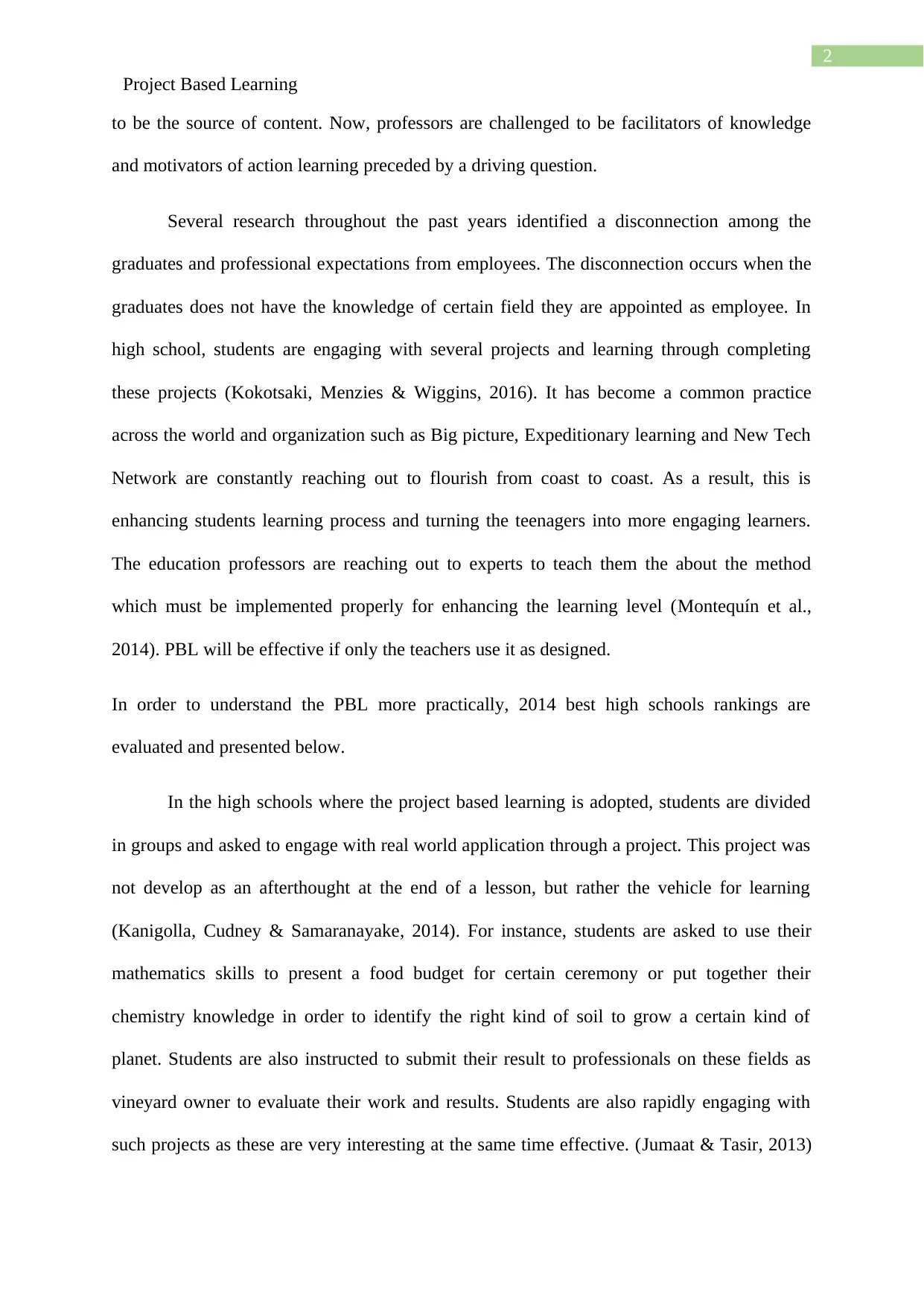
2
Project Based Learning
to be the source of content. Now, professors are challenged to be facilitators of knowledge
and motivators of action learning preceded by a driving question.
Several research throughout the past years identified a disconnection among the
graduates and professional expectations from employees. The disconnection occurs when the
graduates does not have the knowledge of certain field they are appointed as employee. In
high school, students are engaging with several projects and learning through completing
these projects (Kokotsaki, Menzies & Wiggins, 2016). It has become a common practice
across the world and organization such as Big picture, Expeditionary learning and New Tech
Network are constantly reaching out to flourish from coast to coast. As a result, this is
enhancing students learning process and turning the teenagers into more engaging learners.
The education professors are reaching out to experts to teach them the about the method
which must be implemented properly for enhancing the learning level (Montequín et al.,
2014). PBL will be effective if only the teachers use it as designed.
In order to understand the PBL more practically, 2014 best high schools rankings are
evaluated and presented below.
In the high schools where the project based learning is adopted, students are divided
in groups and asked to engage with real world application through a project. This project was
not develop as an afterthought at the end of a lesson, but rather the vehicle for learning
(Kanigolla, Cudney & Samaranayake, 2014). For instance, students are asked to use their
mathematics skills to present a food budget for certain ceremony or put together their
chemistry knowledge in order to identify the right kind of soil to grow a certain kind of
planet. Students are also instructed to submit their result to professionals on these fields as
vineyard owner to evaluate their work and results. Students are also rapidly engaging with
such projects as these are very interesting at the same time effective. (Jumaat & Tasir, 2013)
Project Based Learning
to be the source of content. Now, professors are challenged to be facilitators of knowledge
and motivators of action learning preceded by a driving question.
Several research throughout the past years identified a disconnection among the
graduates and professional expectations from employees. The disconnection occurs when the
graduates does not have the knowledge of certain field they are appointed as employee. In
high school, students are engaging with several projects and learning through completing
these projects (Kokotsaki, Menzies & Wiggins, 2016). It has become a common practice
across the world and organization such as Big picture, Expeditionary learning and New Tech
Network are constantly reaching out to flourish from coast to coast. As a result, this is
enhancing students learning process and turning the teenagers into more engaging learners.
The education professors are reaching out to experts to teach them the about the method
which must be implemented properly for enhancing the learning level (Montequín et al.,
2014). PBL will be effective if only the teachers use it as designed.
In order to understand the PBL more practically, 2014 best high schools rankings are
evaluated and presented below.
In the high schools where the project based learning is adopted, students are divided
in groups and asked to engage with real world application through a project. This project was
not develop as an afterthought at the end of a lesson, but rather the vehicle for learning
(Kanigolla, Cudney & Samaranayake, 2014). For instance, students are asked to use their
mathematics skills to present a food budget for certain ceremony or put together their
chemistry knowledge in order to identify the right kind of soil to grow a certain kind of
planet. Students are also instructed to submit their result to professionals on these fields as
vineyard owner to evaluate their work and results. Students are also rapidly engaging with
such projects as these are very interesting at the same time effective. (Jumaat & Tasir, 2013)
⊘ This is a preview!⊘
Do you want full access?
Subscribe today to unlock all pages.

Trusted by 1+ million students worldwide
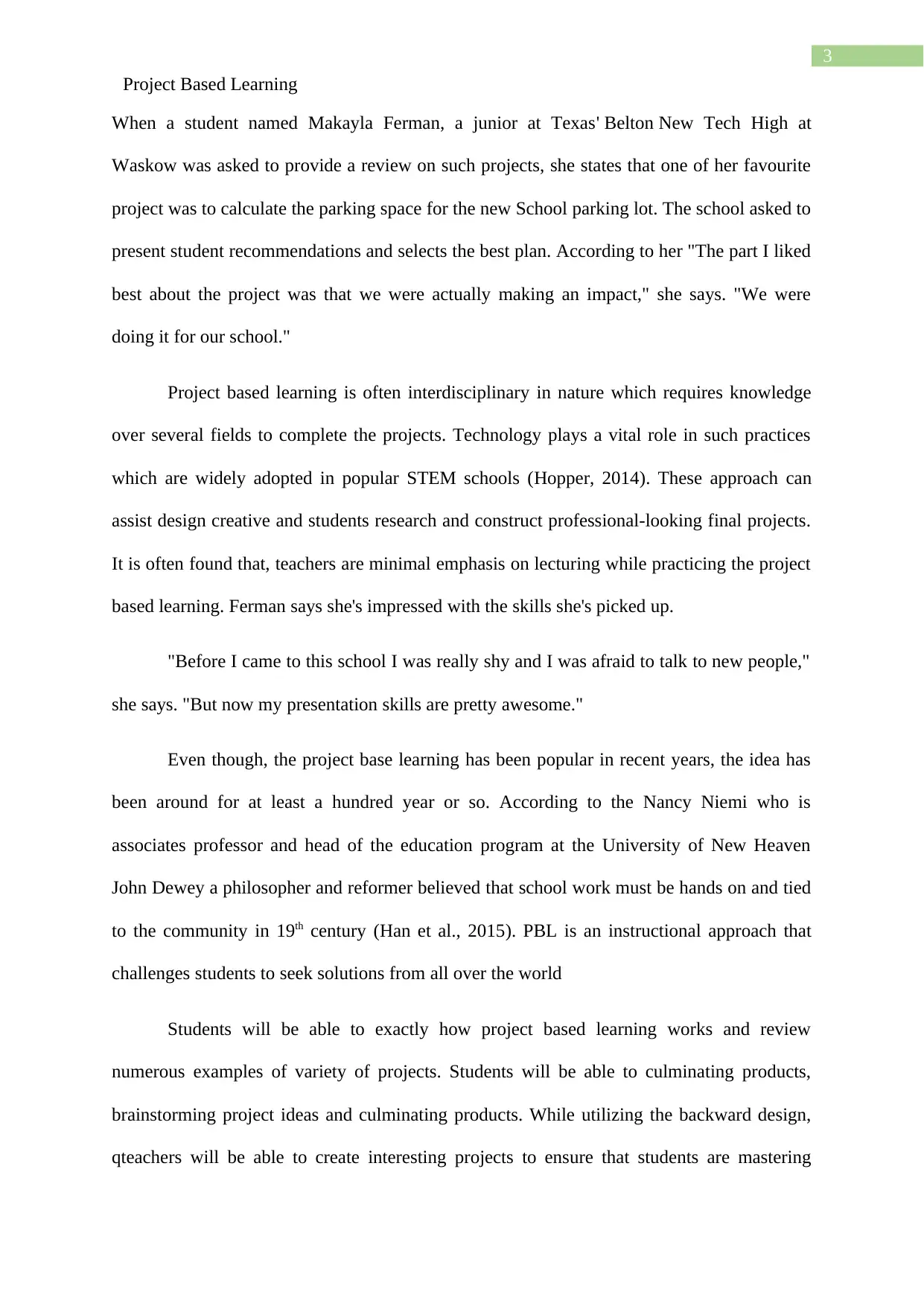
3
Project Based Learning
When a student named Makayla Ferman, a junior at Texas' Belton New Tech High at
Waskow was asked to provide a review on such projects, she states that one of her favourite
project was to calculate the parking space for the new School parking lot. The school asked to
present student recommendations and selects the best plan. According to her "The part I liked
best about the project was that we were actually making an impact," she says. "We were
doing it for our school."
Project based learning is often interdisciplinary in nature which requires knowledge
over several fields to complete the projects. Technology plays a vital role in such practices
which are widely adopted in popular STEM schools (Hopper, 2014). These approach can
assist design creative and students research and construct professional-looking final projects.
It is often found that, teachers are minimal emphasis on lecturing while practicing the project
based learning. Ferman says she's impressed with the skills she's picked up.
"Before I came to this school I was really shy and I was afraid to talk to new people,"
she says. "But now my presentation skills are pretty awesome."
Even though, the project base learning has been popular in recent years, the idea has
been around for at least a hundred year or so. According to the Nancy Niemi who is
associates professor and head of the education program at the University of New Heaven
John Dewey a philosopher and reformer believed that school work must be hands on and tied
to the community in 19th century (Han et al., 2015). PBL is an instructional approach that
challenges students to seek solutions from all over the world
Students will be able to exactly how project based learning works and review
numerous examples of variety of projects. Students will be able to culminating products,
brainstorming project ideas and culminating products. While utilizing the backward design,
qteachers will be able to create interesting projects to ensure that students are mastering
Project Based Learning
When a student named Makayla Ferman, a junior at Texas' Belton New Tech High at
Waskow was asked to provide a review on such projects, she states that one of her favourite
project was to calculate the parking space for the new School parking lot. The school asked to
present student recommendations and selects the best plan. According to her "The part I liked
best about the project was that we were actually making an impact," she says. "We were
doing it for our school."
Project based learning is often interdisciplinary in nature which requires knowledge
over several fields to complete the projects. Technology plays a vital role in such practices
which are widely adopted in popular STEM schools (Hopper, 2014). These approach can
assist design creative and students research and construct professional-looking final projects.
It is often found that, teachers are minimal emphasis on lecturing while practicing the project
based learning. Ferman says she's impressed with the skills she's picked up.
"Before I came to this school I was really shy and I was afraid to talk to new people,"
she says. "But now my presentation skills are pretty awesome."
Even though, the project base learning has been popular in recent years, the idea has
been around for at least a hundred year or so. According to the Nancy Niemi who is
associates professor and head of the education program at the University of New Heaven
John Dewey a philosopher and reformer believed that school work must be hands on and tied
to the community in 19th century (Han et al., 2015). PBL is an instructional approach that
challenges students to seek solutions from all over the world
Students will be able to exactly how project based learning works and review
numerous examples of variety of projects. Students will be able to culminating products,
brainstorming project ideas and culminating products. While utilizing the backward design,
qteachers will be able to create interesting projects to ensure that students are mastering
Paraphrase This Document
Need a fresh take? Get an instant paraphrase of this document with our AI Paraphraser
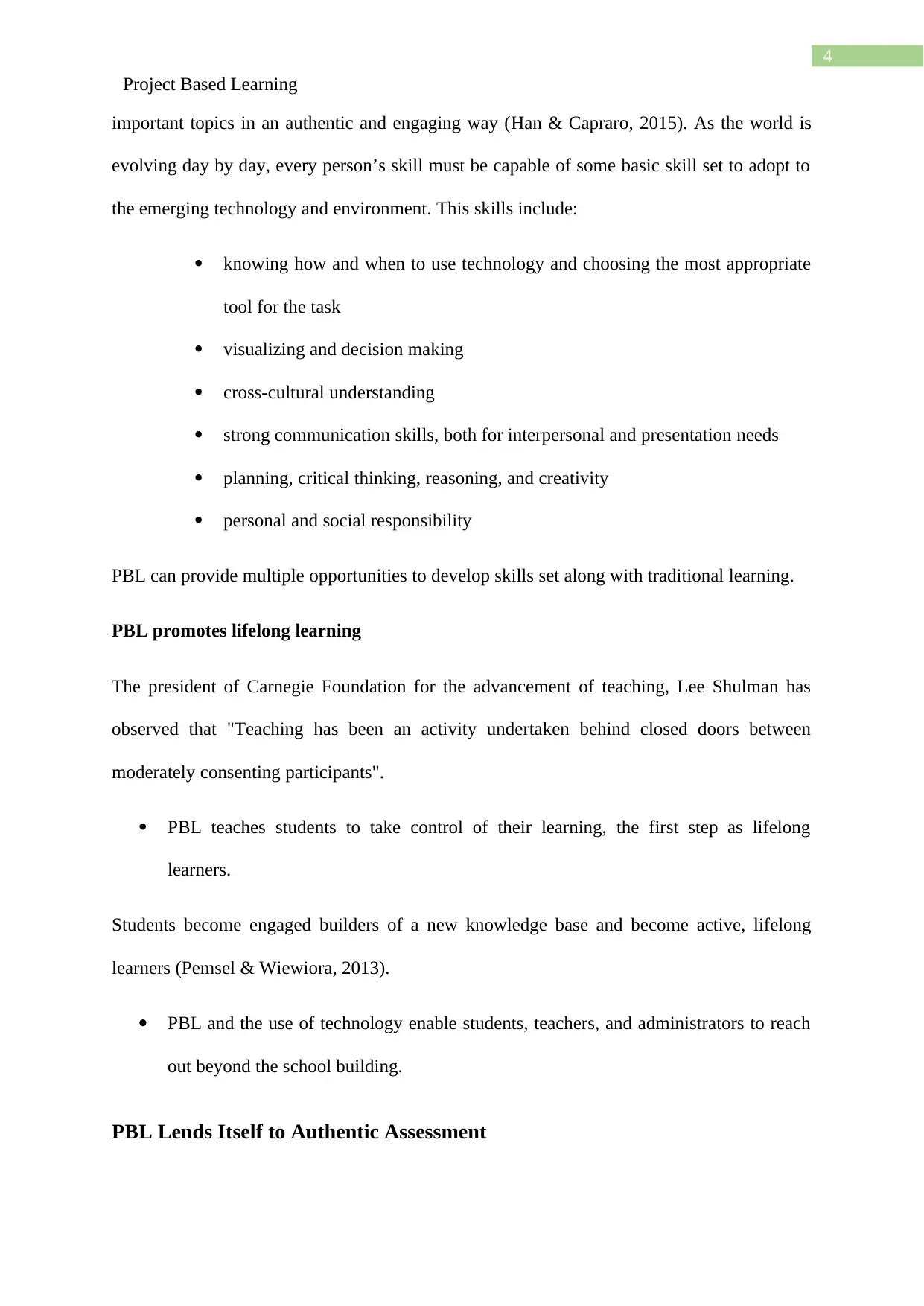
4
Project Based Learning
important topics in an authentic and engaging way (Han & Capraro, 2015). As the world is
evolving day by day, every person’s skill must be capable of some basic skill set to adopt to
the emerging technology and environment. This skills include:
knowing how and when to use technology and choosing the most appropriate
tool for the task
visualizing and decision making
cross-cultural understanding
strong communication skills, both for interpersonal and presentation needs
planning, critical thinking, reasoning, and creativity
personal and social responsibility
PBL can provide multiple opportunities to develop skills set along with traditional learning.
PBL promotes lifelong learning
The president of Carnegie Foundation for the advancement of teaching, Lee Shulman has
observed that "Teaching has been an activity undertaken behind closed doors between
moderately consenting participants".
PBL teaches students to take control of their learning, the first step as lifelong
learners.
Students become engaged builders of a new knowledge base and become active, lifelong
learners (Pemsel & Wiewiora, 2013).
PBL and the use of technology enable students, teachers, and administrators to reach
out beyond the school building.
PBL Lends Itself to Authentic Assessment
Project Based Learning
important topics in an authentic and engaging way (Han & Capraro, 2015). As the world is
evolving day by day, every person’s skill must be capable of some basic skill set to adopt to
the emerging technology and environment. This skills include:
knowing how and when to use technology and choosing the most appropriate
tool for the task
visualizing and decision making
cross-cultural understanding
strong communication skills, both for interpersonal and presentation needs
planning, critical thinking, reasoning, and creativity
personal and social responsibility
PBL can provide multiple opportunities to develop skills set along with traditional learning.
PBL promotes lifelong learning
The president of Carnegie Foundation for the advancement of teaching, Lee Shulman has
observed that "Teaching has been an activity undertaken behind closed doors between
moderately consenting participants".
PBL teaches students to take control of their learning, the first step as lifelong
learners.
Students become engaged builders of a new knowledge base and become active, lifelong
learners (Pemsel & Wiewiora, 2013).
PBL and the use of technology enable students, teachers, and administrators to reach
out beyond the school building.
PBL Lends Itself to Authentic Assessment
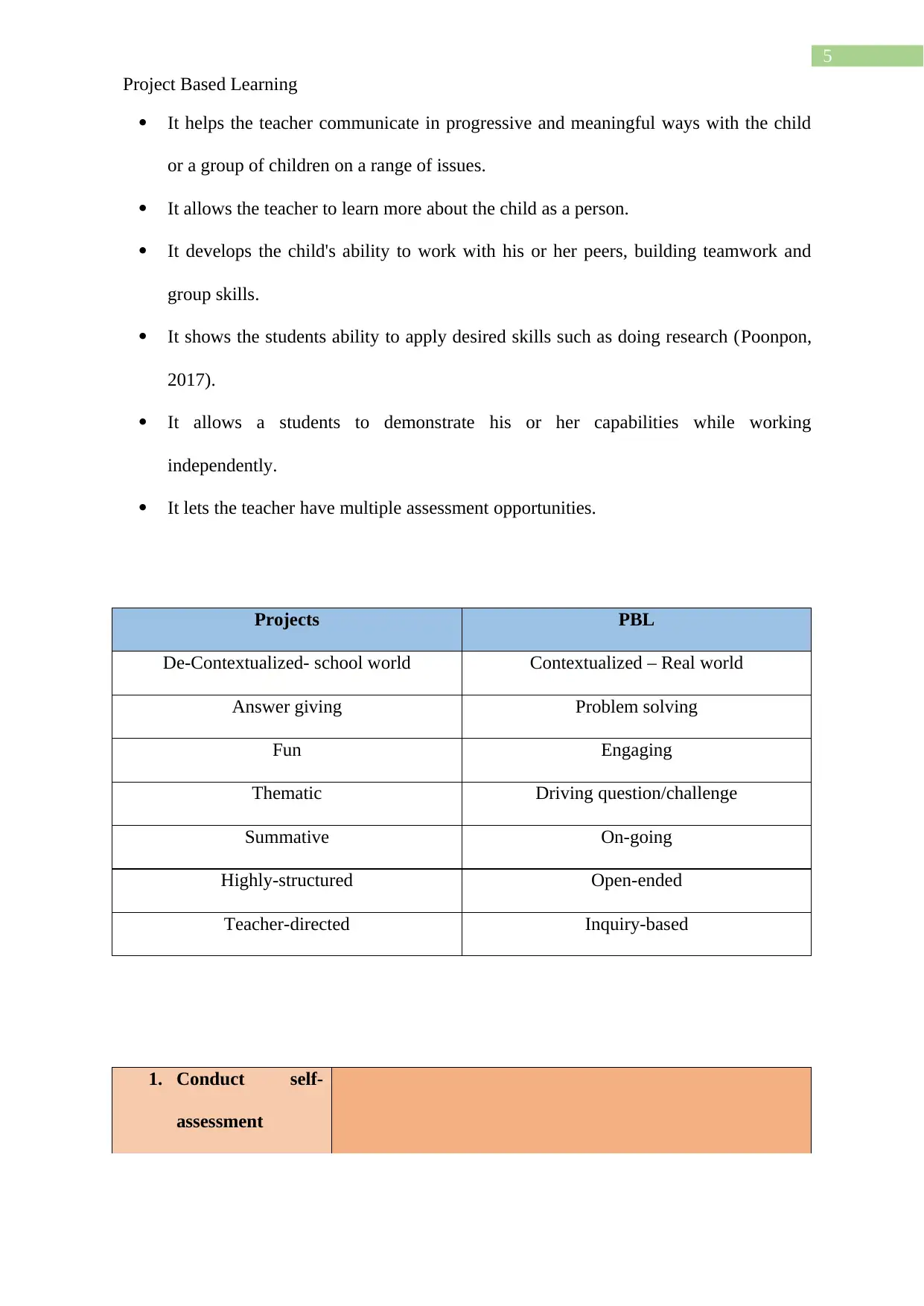
5
Project Based Learning
It helps the teacher communicate in progressive and meaningful ways with the child
or a group of children on a range of issues.
It allows the teacher to learn more about the child as a person.
It develops the child's ability to work with his or her peers, building teamwork and
group skills.
It shows the students ability to apply desired skills such as doing research (Poonpon,
2017).
It allows a students to demonstrate his or her capabilities while working
independently.
It lets the teacher have multiple assessment opportunities.
Projects PBL
De-Contextualized- school world Contextualized – Real world
Answer giving Problem solving
Fun Engaging
Thematic Driving question/challenge
Summative On-going
Highly-structured Open-ended
Teacher-directed Inquiry-based
1. Conduct self-
assessment
Project Based Learning
It helps the teacher communicate in progressive and meaningful ways with the child
or a group of children on a range of issues.
It allows the teacher to learn more about the child as a person.
It develops the child's ability to work with his or her peers, building teamwork and
group skills.
It shows the students ability to apply desired skills such as doing research (Poonpon,
2017).
It allows a students to demonstrate his or her capabilities while working
independently.
It lets the teacher have multiple assessment opportunities.
Projects PBL
De-Contextualized- school world Contextualized – Real world
Answer giving Problem solving
Fun Engaging
Thematic Driving question/challenge
Summative On-going
Highly-structured Open-ended
Teacher-directed Inquiry-based
1. Conduct self-
assessment
⊘ This is a preview!⊘
Do you want full access?
Subscribe today to unlock all pages.

Trusted by 1+ million students worldwide
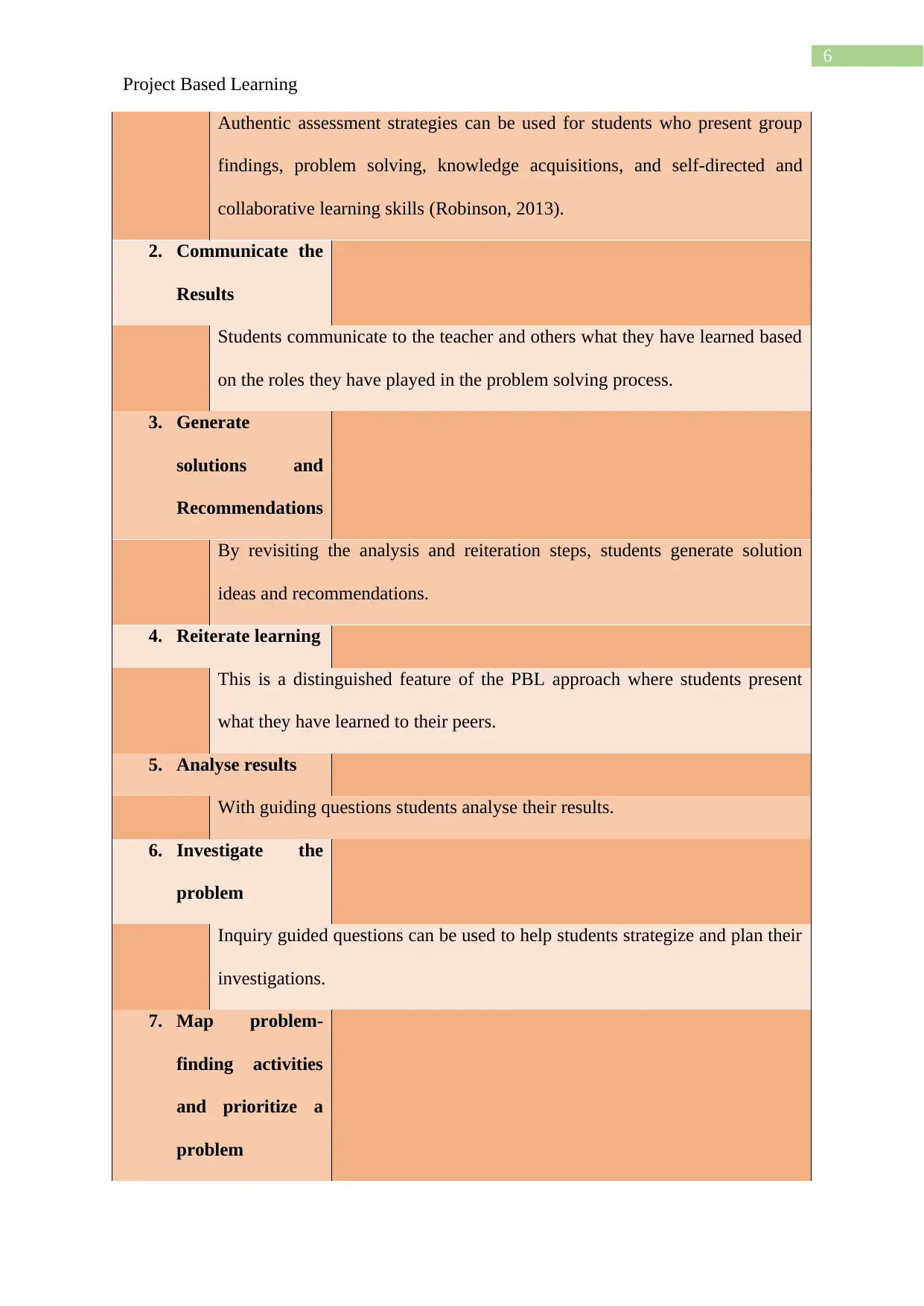
6
Project Based Learning
Authentic assessment strategies can be used for students who present group
findings, problem solving, knowledge acquisitions, and self-directed and
collaborative learning skills (Robinson, 2013).
2. Communicate the
Results
Students communicate to the teacher and others what they have learned based
on the roles they have played in the problem solving process.
3. Generate
solutions and
Recommendations
By revisiting the analysis and reiteration steps, students generate solution
ideas and recommendations.
4. Reiterate learning
This is a distinguished feature of the PBL approach where students present
what they have learned to their peers.
5. Analyse results
With guiding questions students analyse their results.
6. Investigate the
problem
Inquiry guided questions can be used to help students strategize and plan their
investigations.
7. Map problem-
finding activities
and prioritize a
problem
Project Based Learning
Authentic assessment strategies can be used for students who present group
findings, problem solving, knowledge acquisitions, and self-directed and
collaborative learning skills (Robinson, 2013).
2. Communicate the
Results
Students communicate to the teacher and others what they have learned based
on the roles they have played in the problem solving process.
3. Generate
solutions and
Recommendations
By revisiting the analysis and reiteration steps, students generate solution
ideas and recommendations.
4. Reiterate learning
This is a distinguished feature of the PBL approach where students present
what they have learned to their peers.
5. Analyse results
With guiding questions students analyse their results.
6. Investigate the
problem
Inquiry guided questions can be used to help students strategize and plan their
investigations.
7. Map problem-
finding activities
and prioritize a
problem
Paraphrase This Document
Need a fresh take? Get an instant paraphrase of this document with our AI Paraphraser
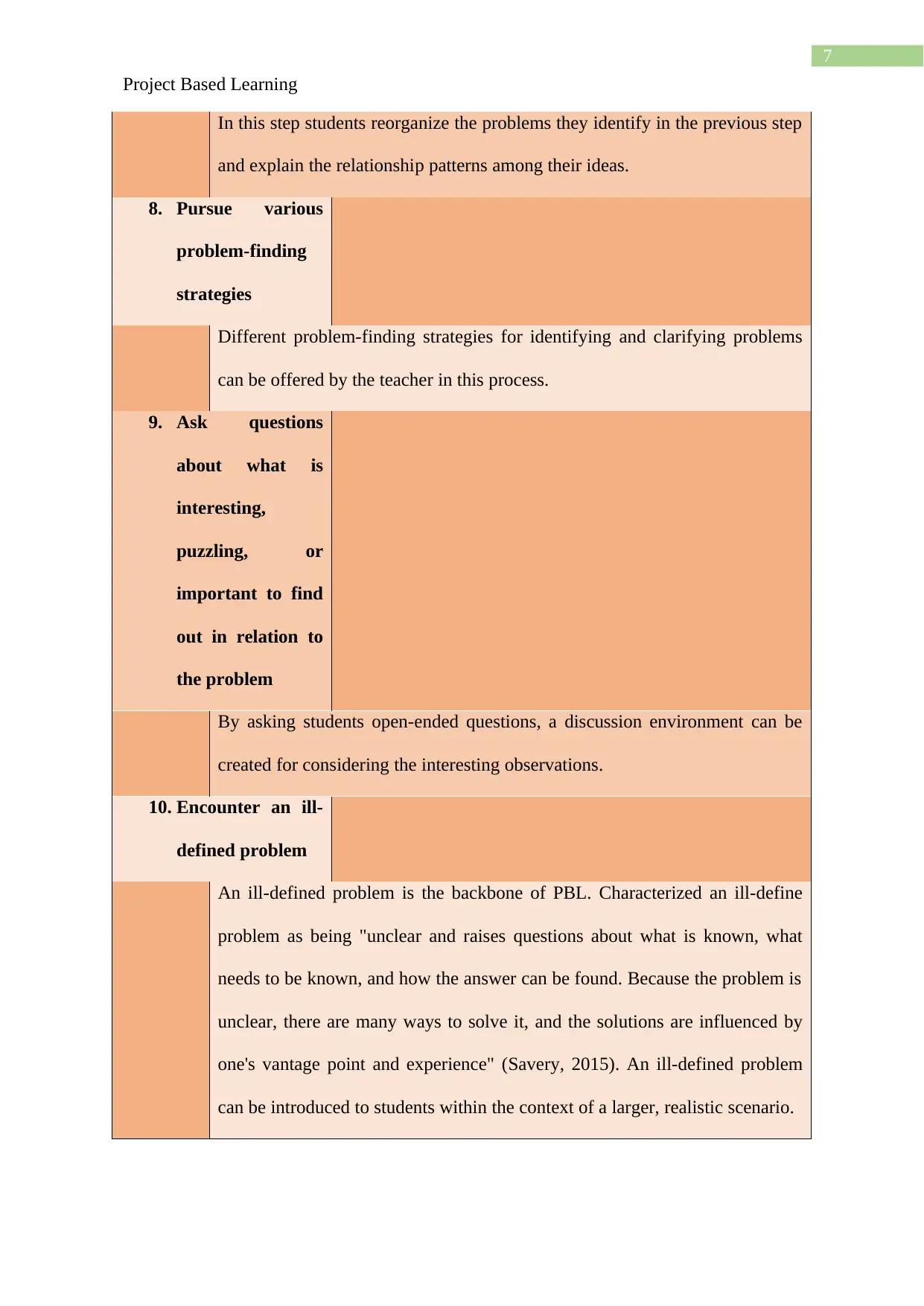
7
Project Based Learning
In this step students reorganize the problems they identify in the previous step
and explain the relationship patterns among their ideas.
8. Pursue various
problem-finding
strategies
Different problem-finding strategies for identifying and clarifying problems
can be offered by the teacher in this process.
9. Ask questions
about what is
interesting,
puzzling, or
important to find
out in relation to
the problem
By asking students open-ended questions, a discussion environment can be
created for considering the interesting observations.
10. Encounter an ill-
defined problem
An ill-defined problem is the backbone of PBL. Characterized an ill-define
problem as being "unclear and raises questions about what is known, what
needs to be known, and how the answer can be found. Because the problem is
unclear, there are many ways to solve it, and the solutions are influenced by
one's vantage point and experience" (Savery, 2015). An ill-defined problem
can be introduced to students within the context of a larger, realistic scenario.
Project Based Learning
In this step students reorganize the problems they identify in the previous step
and explain the relationship patterns among their ideas.
8. Pursue various
problem-finding
strategies
Different problem-finding strategies for identifying and clarifying problems
can be offered by the teacher in this process.
9. Ask questions
about what is
interesting,
puzzling, or
important to find
out in relation to
the problem
By asking students open-ended questions, a discussion environment can be
created for considering the interesting observations.
10. Encounter an ill-
defined problem
An ill-defined problem is the backbone of PBL. Characterized an ill-define
problem as being "unclear and raises questions about what is known, what
needs to be known, and how the answer can be found. Because the problem is
unclear, there are many ways to solve it, and the solutions are influenced by
one's vantage point and experience" (Savery, 2015). An ill-defined problem
can be introduced to students within the context of a larger, realistic scenario.
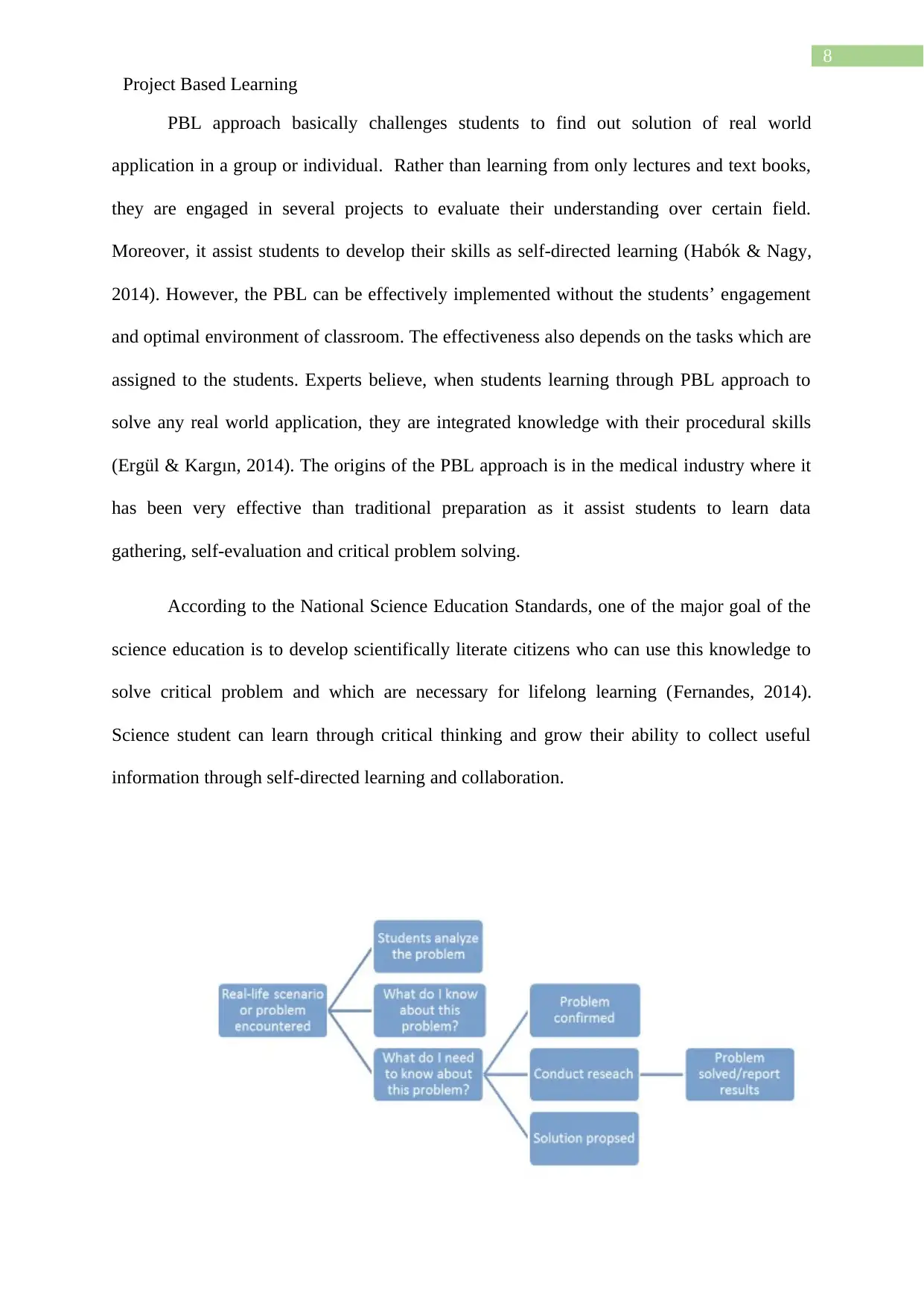
8
Project Based Learning
PBL approach basically challenges students to find out solution of real world
application in a group or individual. Rather than learning from only lectures and text books,
they are engaged in several projects to evaluate their understanding over certain field.
Moreover, it assist students to develop their skills as self-directed learning (Habók & Nagy,
2014). However, the PBL can be effectively implemented without the students’ engagement
and optimal environment of classroom. The effectiveness also depends on the tasks which are
assigned to the students. Experts believe, when students learning through PBL approach to
solve any real world application, they are integrated knowledge with their procedural skills
(Ergül & Kargın, 2014). The origins of the PBL approach is in the medical industry where it
has been very effective than traditional preparation as it assist students to learn data
gathering, self-evaluation and critical problem solving.
According to the National Science Education Standards, one of the major goal of the
science education is to develop scientifically literate citizens who can use this knowledge to
solve critical problem and which are necessary for lifelong learning (Fernandes, 2014).
Science student can learn through critical thinking and grow their ability to collect useful
information through self-directed learning and collaboration.
Project Based Learning
PBL approach basically challenges students to find out solution of real world
application in a group or individual. Rather than learning from only lectures and text books,
they are engaged in several projects to evaluate their understanding over certain field.
Moreover, it assist students to develop their skills as self-directed learning (Habók & Nagy,
2014). However, the PBL can be effectively implemented without the students’ engagement
and optimal environment of classroom. The effectiveness also depends on the tasks which are
assigned to the students. Experts believe, when students learning through PBL approach to
solve any real world application, they are integrated knowledge with their procedural skills
(Ergül & Kargın, 2014). The origins of the PBL approach is in the medical industry where it
has been very effective than traditional preparation as it assist students to learn data
gathering, self-evaluation and critical problem solving.
According to the National Science Education Standards, one of the major goal of the
science education is to develop scientifically literate citizens who can use this knowledge to
solve critical problem and which are necessary for lifelong learning (Fernandes, 2014).
Science student can learn through critical thinking and grow their ability to collect useful
information through self-directed learning and collaboration.
⊘ This is a preview!⊘
Do you want full access?
Subscribe today to unlock all pages.

Trusted by 1+ million students worldwide
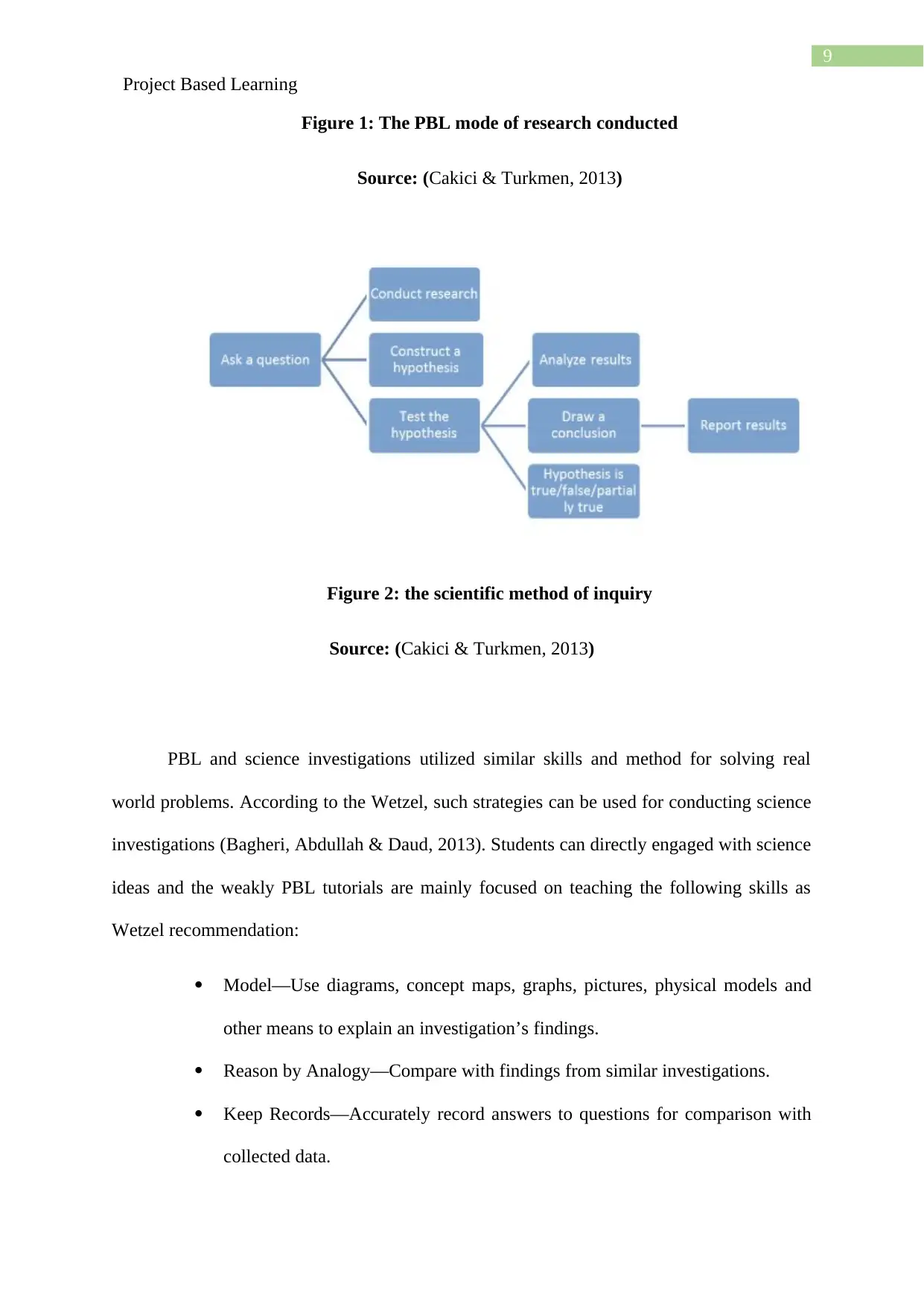
9
Project Based Learning
Figure 1: The PBL mode of research conducted
Source: (Cakici & Turkmen, 2013)
Figure 2: the scientific method of inquiry
Source: (Cakici & Turkmen, 2013)
PBL and science investigations utilized similar skills and method for solving real
world problems. According to the Wetzel, such strategies can be used for conducting science
investigations (Bagheri, Abdullah & Daud, 2013). Students can directly engaged with science
ideas and the weakly PBL tutorials are mainly focused on teaching the following skills as
Wetzel recommendation:
Model—Use diagrams, concept maps, graphs, pictures, physical models and
other means to explain an investigation’s findings.
Reason by Analogy—Compare with findings from similar investigations.
Keep Records—Accurately record answers to questions for comparison with
collected data.
Project Based Learning
Figure 1: The PBL mode of research conducted
Source: (Cakici & Turkmen, 2013)
Figure 2: the scientific method of inquiry
Source: (Cakici & Turkmen, 2013)
PBL and science investigations utilized similar skills and method for solving real
world problems. According to the Wetzel, such strategies can be used for conducting science
investigations (Bagheri, Abdullah & Daud, 2013). Students can directly engaged with science
ideas and the weakly PBL tutorials are mainly focused on teaching the following skills as
Wetzel recommendation:
Model—Use diagrams, concept maps, graphs, pictures, physical models and
other means to explain an investigation’s findings.
Reason by Analogy—Compare with findings from similar investigations.
Keep Records—Accurately record answers to questions for comparison with
collected data.
Paraphrase This Document
Need a fresh take? Get an instant paraphrase of this document with our AI Paraphraser
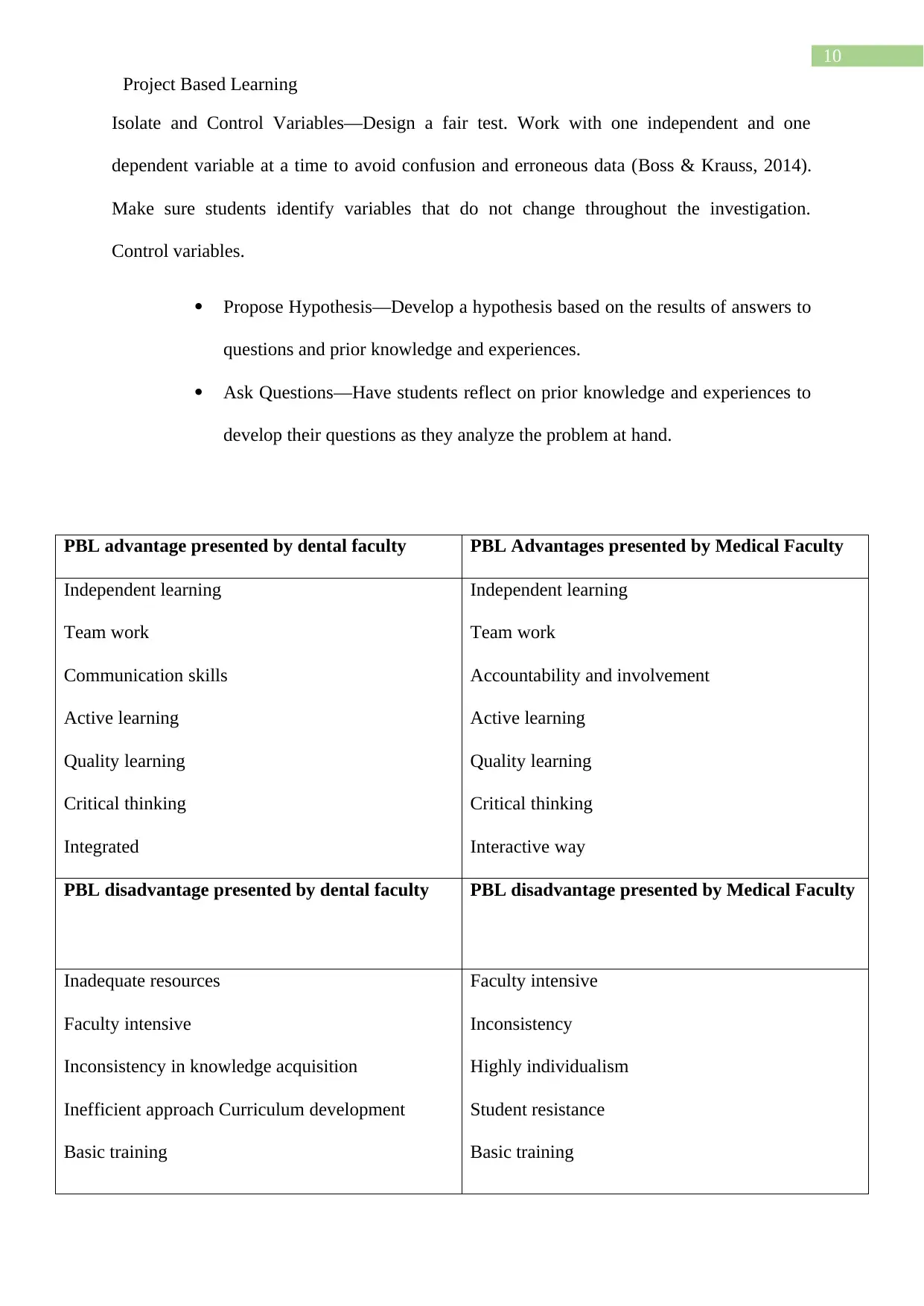
10
Project Based Learning
Isolate and Control Variables—Design a fair test. Work with one independent and one
dependent variable at a time to avoid confusion and erroneous data (Boss & Krauss, 2014).
Make sure students identify variables that do not change throughout the investigation.
Control variables.
Propose Hypothesis—Develop a hypothesis based on the results of answers to
questions and prior knowledge and experiences.
Ask Questions—Have students reflect on prior knowledge and experiences to
develop their questions as they analyze the problem at hand.
PBL advantage presented by dental faculty PBL Advantages presented by Medical Faculty
Independent learning
Team work
Communication skills
Active learning
Quality learning
Critical thinking
Integrated
Independent learning
Team work
Accountability and involvement
Active learning
Quality learning
Critical thinking
Interactive way
PBL disadvantage presented by dental faculty PBL disadvantage presented by Medical Faculty
Inadequate resources
Faculty intensive
Inconsistency in knowledge acquisition
Inefficient approach Curriculum development
Basic training
Faculty intensive
Inconsistency
Highly individualism
Student resistance
Basic training
Project Based Learning
Isolate and Control Variables—Design a fair test. Work with one independent and one
dependent variable at a time to avoid confusion and erroneous data (Boss & Krauss, 2014).
Make sure students identify variables that do not change throughout the investigation.
Control variables.
Propose Hypothesis—Develop a hypothesis based on the results of answers to
questions and prior knowledge and experiences.
Ask Questions—Have students reflect on prior knowledge and experiences to
develop their questions as they analyze the problem at hand.
PBL advantage presented by dental faculty PBL Advantages presented by Medical Faculty
Independent learning
Team work
Communication skills
Active learning
Quality learning
Critical thinking
Integrated
Independent learning
Team work
Accountability and involvement
Active learning
Quality learning
Critical thinking
Interactive way
PBL disadvantage presented by dental faculty PBL disadvantage presented by Medical Faculty
Inadequate resources
Faculty intensive
Inconsistency in knowledge acquisition
Inefficient approach Curriculum development
Basic training
Faculty intensive
Inconsistency
Highly individualism
Student resistance
Basic training
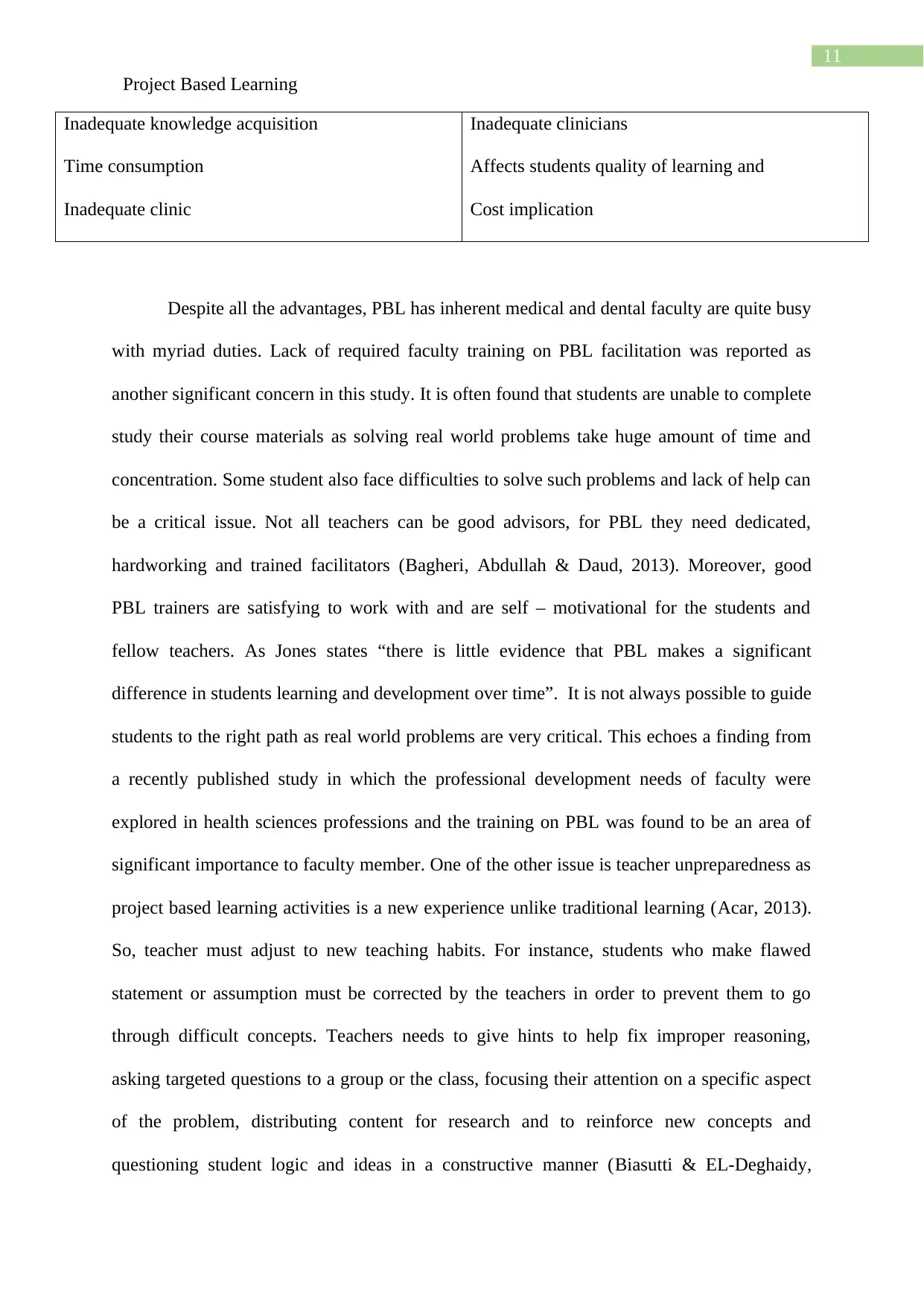
11
Project Based Learning
Inadequate knowledge acquisition
Time consumption
Inadequate clinic
Inadequate clinicians
Affects students quality of learning and
Cost implication
Despite all the advantages, PBL has inherent medical and dental faculty are quite busy
with myriad duties. Lack of required faculty training on PBL facilitation was reported as
another significant concern in this study. It is often found that students are unable to complete
study their course materials as solving real world problems take huge amount of time and
concentration. Some student also face difficulties to solve such problems and lack of help can
be a critical issue. Not all teachers can be good advisors, for PBL they need dedicated,
hardworking and trained facilitators (Bagheri, Abdullah & Daud, 2013). Moreover, good
PBL trainers are satisfying to work with and are self – motivational for the students and
fellow teachers. As Jones states “there is little evidence that PBL makes a significant
difference in students learning and development over time”. It is not always possible to guide
students to the right path as real world problems are very critical. This echoes a finding from
a recently published study in which the professional development needs of faculty were
explored in health sciences professions and the training on PBL was found to be an area of
significant importance to faculty member. One of the other issue is teacher unpreparedness as
project based learning activities is a new experience unlike traditional learning (Acar, 2013).
So, teacher must adjust to new teaching habits. For instance, students who make flawed
statement or assumption must be corrected by the teachers in order to prevent them to go
through difficult concepts. Teachers needs to give hints to help fix improper reasoning,
asking targeted questions to a group or the class, focusing their attention on a specific aspect
of the problem, distributing content for research and to reinforce new concepts and
questioning student logic and ideas in a constructive manner (Biasutti & EL-Deghaidy,
Project Based Learning
Inadequate knowledge acquisition
Time consumption
Inadequate clinic
Inadequate clinicians
Affects students quality of learning and
Cost implication
Despite all the advantages, PBL has inherent medical and dental faculty are quite busy
with myriad duties. Lack of required faculty training on PBL facilitation was reported as
another significant concern in this study. It is often found that students are unable to complete
study their course materials as solving real world problems take huge amount of time and
concentration. Some student also face difficulties to solve such problems and lack of help can
be a critical issue. Not all teachers can be good advisors, for PBL they need dedicated,
hardworking and trained facilitators (Bagheri, Abdullah & Daud, 2013). Moreover, good
PBL trainers are satisfying to work with and are self – motivational for the students and
fellow teachers. As Jones states “there is little evidence that PBL makes a significant
difference in students learning and development over time”. It is not always possible to guide
students to the right path as real world problems are very critical. This echoes a finding from
a recently published study in which the professional development needs of faculty were
explored in health sciences professions and the training on PBL was found to be an area of
significant importance to faculty member. One of the other issue is teacher unpreparedness as
project based learning activities is a new experience unlike traditional learning (Acar, 2013).
So, teacher must adjust to new teaching habits. For instance, students who make flawed
statement or assumption must be corrected by the teachers in order to prevent them to go
through difficult concepts. Teachers needs to give hints to help fix improper reasoning,
asking targeted questions to a group or the class, focusing their attention on a specific aspect
of the problem, distributing content for research and to reinforce new concepts and
questioning student logic and ideas in a constructive manner (Biasutti & EL-Deghaidy,
⊘ This is a preview!⊘
Do you want full access?
Subscribe today to unlock all pages.

Trusted by 1+ million students worldwide
1 out of 19
Related Documents
Your All-in-One AI-Powered Toolkit for Academic Success.
+13062052269
info@desklib.com
Available 24*7 on WhatsApp / Email
![[object Object]](/_next/static/media/star-bottom.7253800d.svg)
Unlock your academic potential
Copyright © 2020–2025 A2Z Services. All Rights Reserved. Developed and managed by ZUCOL.





